Bio Decontamination Market Size
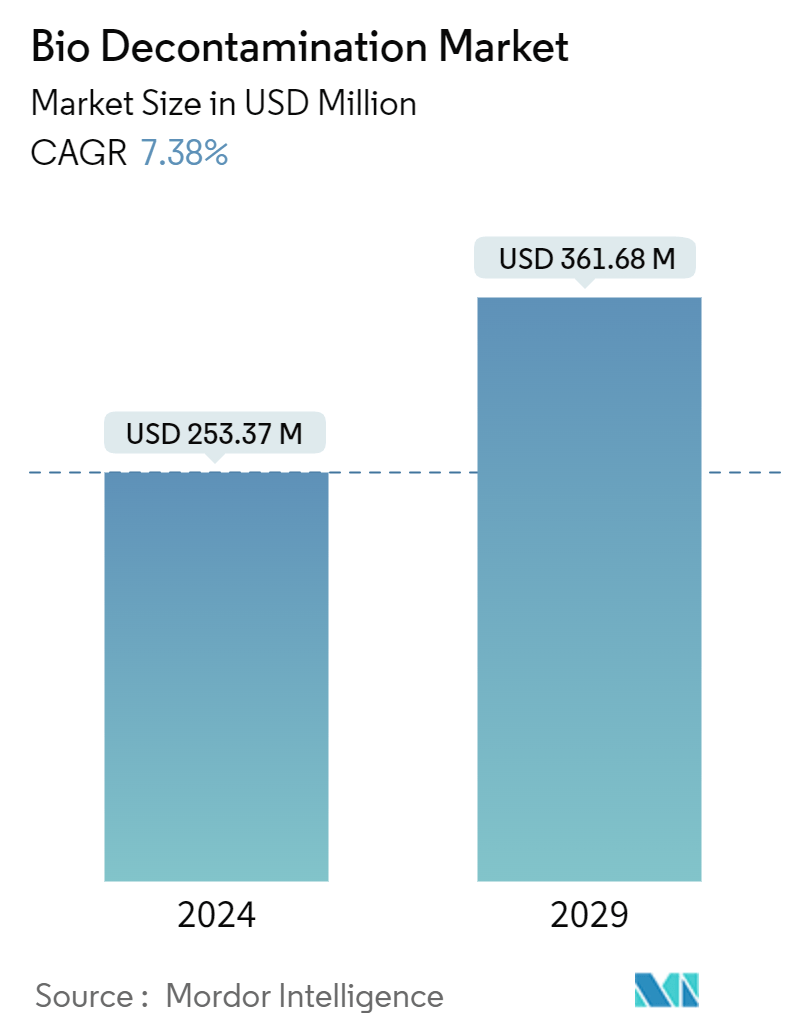
| Study Period | 2019 - 2029 |
| Market Size (2024) | USD 253.37 Million |
| Market Size (2029) | USD 361.68 Million |
| CAGR (2024 - 2029) | 7.38 % |
| Fastest Growing Market | Asia-Pacific |
| Largest Market | North America |
Major Players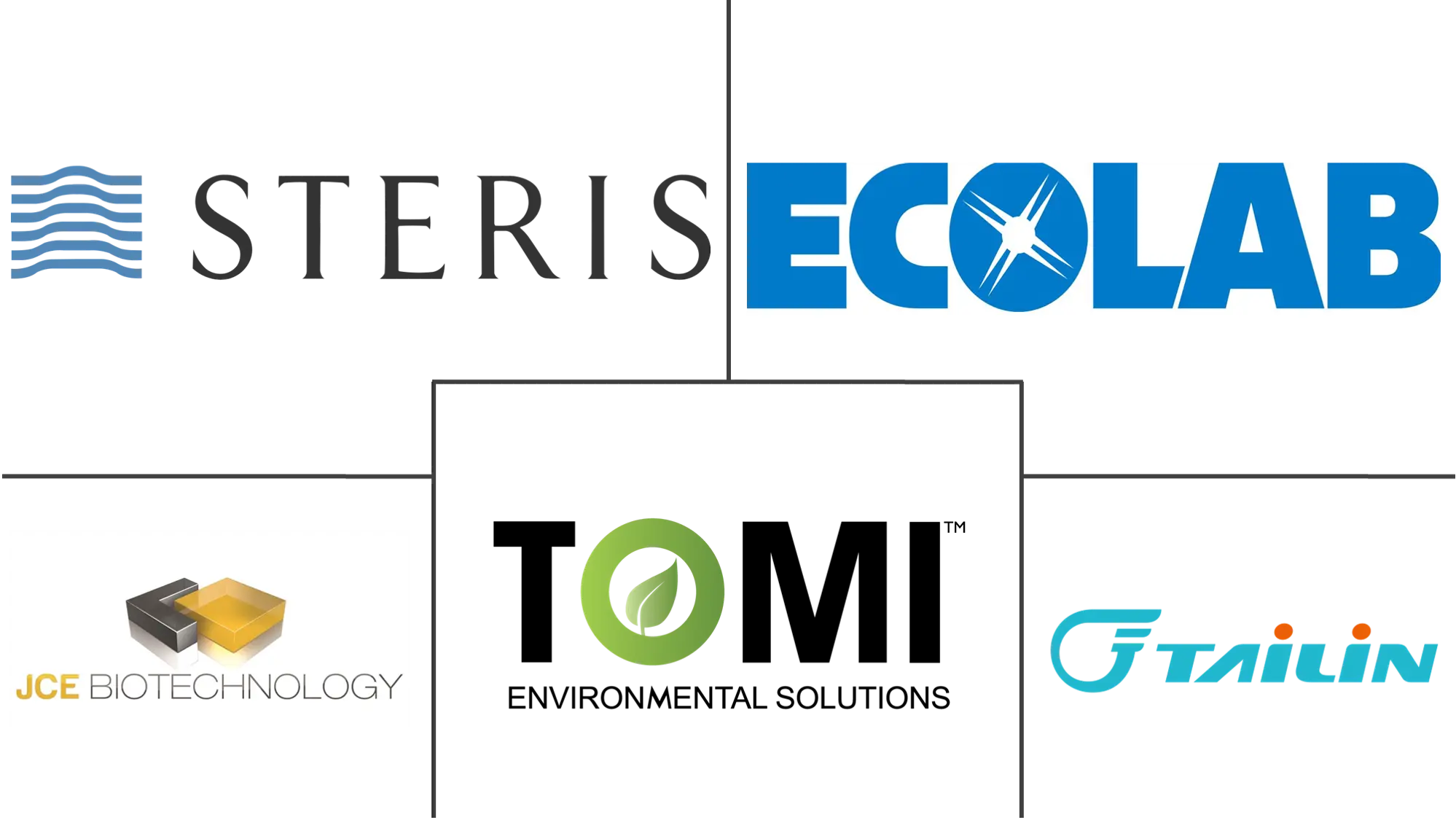
*Disclaimer: Major Players sorted in no particular order |
Bio Decontamination Market Analysis
The Bio Decontamination Market size is estimated at USD 253.37 million in 2024, and is expected to reach USD 361.68 million by 2029, growing at a CAGR of 7.38% during the forecast period (2024-2029).
- The bio decontamination market plays a pivotal role in safeguarding industries where hygiene and safety are paramount, such as healthcare, pharmaceuticals, and biotechnology. As regulatory standards become increasingly stringent and awareness of infection control rises, the demand for effective bio decontamination methods has surged. This market spans a comprehensive range of products and services, including bio decontamination equipment, services, and consumables, all designed to prevent contamination in environments requiring strict cleanliness.
- The growth of this market is driven by several key factors. Foremost among these is the rising incidence of hospital-acquired infections (HAIs), which necessitates enhanced bio decontamination protocols. Additionally, the increasing number of surgical procedures and the growing trend of outsourcing bio decontamination services are significant contributors to market expansion. Healthcare facilities, pharmaceutical companies, and research institutions are increasingly adopting advanced bio decontamination systems to ensure sterile environments and comply with industry regulations.
- Key players in the bio decontamination industry, such as Ecolab, Steris plc, and Tomi Environmental Solutions Inc., offer diverse bio decontamination solutions tailored to specific applications. These solutions include hydrogen peroxide vapor systems, chlorine dioxide systems, and other advanced technologies that deliver high decontamination efficacy, catering to the needs of various sectors.
Hospital-Acquired Infections: A Growing Concern for Healthcare Facilities
- Rising HAI Incidences: Hospital-acquired infections (HAIs) are a growing concern in the healthcare industry, prompting a greater focus on effective bio decontamination solutions. HAIs lead to increased patient morbidity and healthcare costs, driving healthcare facilities to invest in advanced decontamination methods to mitigate infection risks.
- Infection Control Protocols: The enforcement of strict infection control protocols has heightened the demand for bio decontamination equipment and services. Hospitals increasingly rely on automated bio decontamination systems to ensure comprehensive sterilization of critical areas such as operating rooms and intensive care units.
- Government Regulations: Government mandates on hygiene standards are fueling the adoption of bio decontamination technologies. These regulations are particularly stringent in healthcare settings, where the need for sterile environments is critical to patient safety.
- Outsourcing Services: The growing awareness of HAIs has led healthcare facilities to outsource bio decontamination services to specialized companies. This trend enables hospitals to access the latest technologies and expertise, ensuring compliance with the highest cleanliness standards.
Increasing Number of Surgical Procedures: Driving Demand for Advanced Bio Decontamination Solutions
- Global Surgical Growth: The increasing number of surgical procedures worldwide, particularly in regions with aging populations, is driving the demand for bio decontamination equipment and services. Sterile environments in operating rooms and post-operative care units are crucial to preventing infections and ensuring positive patient outcomes.
- Investment in Technologies: Hospitals and surgical centers are investing in cutting-edge bio decontamination technologies to maintain high sterility levels. Automated systems that quickly and effectively decontaminate large areas are becoming essential tools for enhancing operational efficiency.
- Minimally Invasive Surgery: The growing popularity of minimally invasive and robotic surgeries is also boosting the need for advanced bio decontamination solutions. These procedures require ultra-sterile environments to prevent infections that could jeopardize patient safety and surgical success.
- Evolving Surgical Technology: As surgical technology evolves, the bio decontamination market is expected to grow, driven by innovations that offer faster, more efficient, and more effective decontamination processes.
Bio Decontamination Market Trends
The Hydrogen Peroxide Segment is Expected to Hold a Significant Growth Rate During the Forecast Period
- Hydrogen Peroxide Segment Set for Robust Growth: The hydrogen peroxide segment is poised for significant growth due to its effectiveness in eradicating a wide range of pathogens. The adoption of hydrogen peroxide vapor (HPV) technology is expanding, especially in environments that require frequent and thorough sterilization, such as operating rooms and cleanrooms.
- Expansion in Applications: The bio decontamination market is witnessing an expansion in the applications of hydrogen peroxide, particularly in the decontamination of medical devices. Advancements in delivery systems, such as vaporized hydrogen peroxide (VHP) and hydrogen peroxide gas plasma (HPGP), are enhancing the efficiency of decontamination processes.
- Sustainability Trends: The industry's focus on sustainability is driving the adoption of hydrogen peroxide as an eco-friendly decontamination method. Its environmental benefits, coupled with its ability to penetrate complex geometries, make it an ideal choice for critical applications.
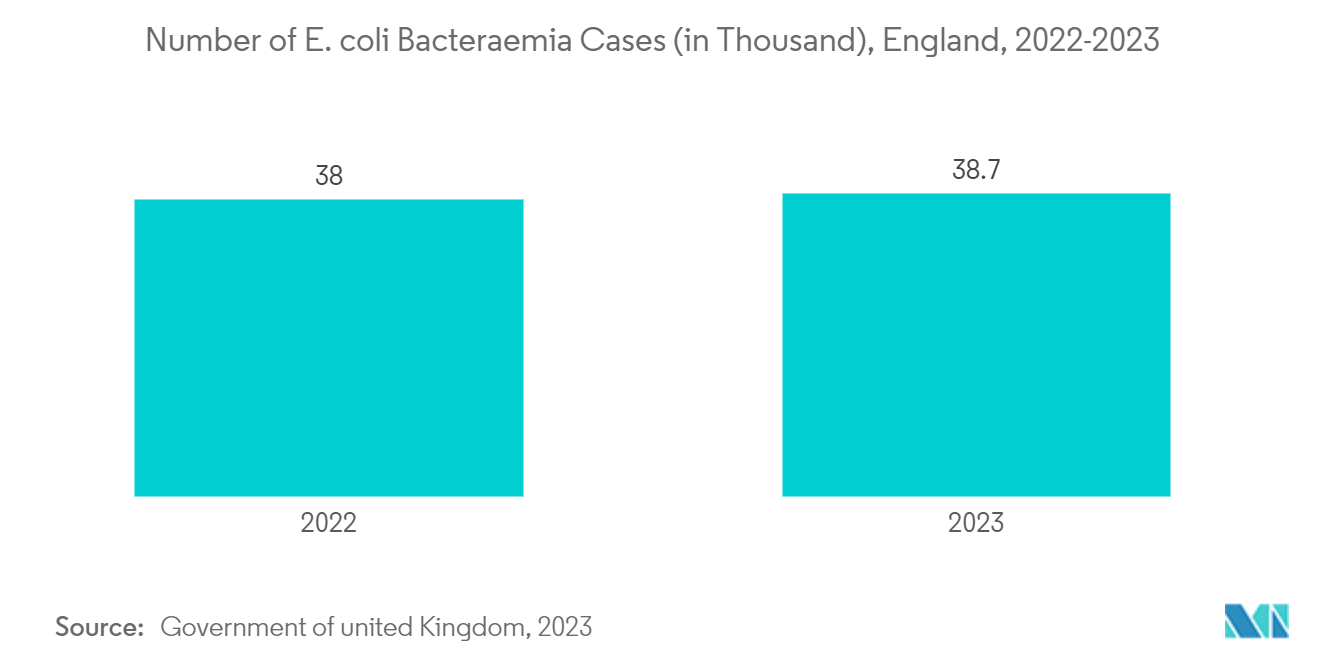
North America is Expected to Hold a Significant Market Share During the Forecast Period
- North America’s Market Dominance: North America is expected to lead the global bio decontamination market, driven by advanced healthcare infrastructure and stringent regulations. The U.S., in particular, is at the forefront, with significant investments in bio decontamination systems aimed at improving infection control and maintaining high cleanliness standards.
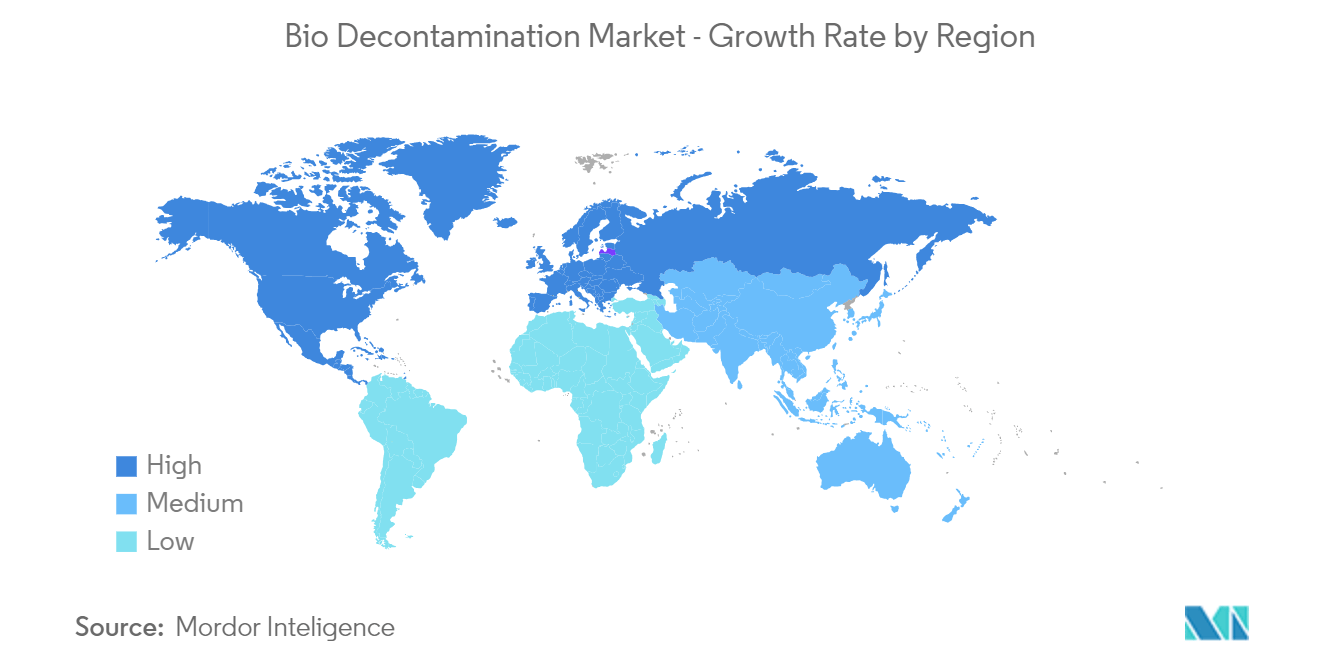
Bio Decontamination Industry Overview
- Moderate Market Consolidation: The bio decontamination market is moderately consolidated, with a mix of global conglomerates and specialized companies. Key players include Ecolab, JCE Biotechnology, Zhejiang Tailin Bioengineering Co., Ltd., Steris Plc, and Tomi Environmental Solutions Inc. These companies dominate the market through their extensive global reach and robust product portfolios.
- Emerging Companies: Emerging players, such as Amira S.r.l., ClorDiSys Solutions Inc., and Noxilizer, Inc., are gaining market traction by focusing on innovation and addressing niche market needs. These companies are carving out a space in the market by developing advanced bio decontamination technologies that meet stringent regulatory standards.
- Innovation and Compliance: Success in the bio decontamination market hinges on continuous innovation, adherence to regulatory standards, and global market expansion. Companies that develop advanced technologies and expand into emerging markets will be well-positioned for growth.
- Sustainability as a Key Factor: As the market evolves, agility in addressing new challenges, such as the demand for environmentally friendly solutions, will be crucial. Companies that prioritize sustainability in their product offerings will likely see increased market share.
- This analysis underscores the critical role of bio decontamination in maintaining safety and hygiene across various sectors, particularly healthcare. The market is driven by the rising incidence of hospital-acquired infections, the increasing number of surgical procedures, and the growing trend of outsourcing bio decontamination services. As the market evolves, the adoption of innovative technologies and a focus on sustainability will shape its future trajectory.
Bio Decontamination Market Leaders
-
Ecolab
-
JCE Biotechnology
-
Zhejiang Tailin Bioengineering Co., Ltd.
-
Steris Plc
-
Tomi Environmental Solutions Inc.
*Disclaimer: Major Players sorted in no particular order
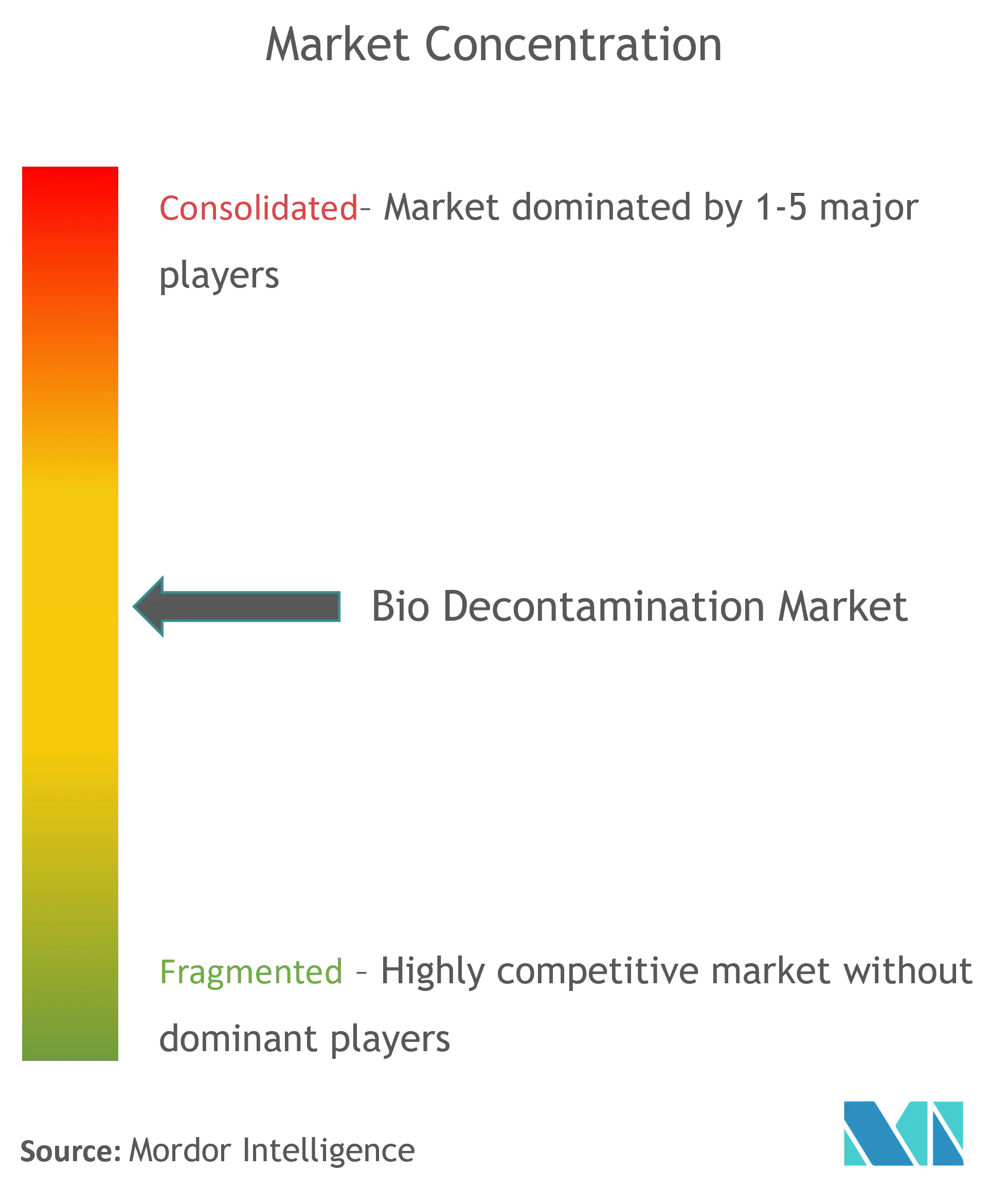
Bio Decontamination Market News
- In June 2024, Amira introduced Bioreset Max, designed for biohazard laboratories and unclassified environments. Its compact size enables operators to navigate small spaces easily. This gas-based de-contaminating agent spreads uniformly, effectively reaching challenging spots. It guarantees a significant microbial load reduction (6 Log) across all surfaces.
- In September 2023, LanzaTech Global Inc. collaborated with Dow to introduce a new biodegradable surfactant to the home care market.
Bio Decontamination Market Report - Table of Contents
1. INTRODUCTION
- 1.1 Study Assumptions and Market Definition
- 1.2 Scope of the Study
2. RESEARCH METHODOLOGY
3. EXECUTIVE SUMMARY
4. MARKET DYNAMICS
- 4.1 Market Overview
-
4.2 Market Drivers
- 4.2.1 Rising Incidence of Hospital-acquired Infections
- 4.2.2 Increasing Number of Surgical Procedures
- 4.2.3 Increasing Outsourcing of Bio-decontamination Services
-
4.3 Market Restraints
- 4.3.1 Budgetary Constraints in Healthcare Facilities
-
4.4 Porter's Five Forces Analysis
- 4.4.1 Threat of New Entrants
- 4.4.2 Bargaining Power of Buyers/Consumers
- 4.4.3 Bargaining Power of Suppliers
- 4.4.4 Threat of Substitute Products
- 4.4.5 Intensity of Competitive Rivalry
5. MARKET SEGMENTATION (Market Size by Value - USD)
-
5.1 By Product and Service
- 5.1.1 Equipment
- 5.1.2 Services
- 5.1.3 Consumables
-
5.2 By Agent Type
- 5.2.1 Hydrogen Peroxide
- 5.2.2 Chlorine Dioxide
- 5.2.3 Peracetic Acid
- 5.2.4 Nitrogen Dioxide
-
5.3 By End User
- 5.3.1 Pharmaceutical and Medical Device Manufacturing Companies
- 5.3.2 Life Sciences and Biotechnology Research Organizations
- 5.3.3 Hospitals and Healthcare Facilities
-
5.4 Geography
- 5.4.1 North America
- 5.4.1.1 United States
- 5.4.1.2 Canada
- 5.4.1.3 Mexico
- 5.4.2 Europe
- 5.4.2.1 Germany
- 5.4.2.2 United Kingdom
- 5.4.2.3 France
- 5.4.2.4 Italy
- 5.4.2.5 Spain
- 5.4.2.6 Rest of Europe
- 5.4.3 Asia-Pacific
- 5.4.3.1 China
- 5.4.3.2 Japan
- 5.4.3.3 India
- 5.4.3.4 Australia
- 5.4.3.5 South Korea
- 5.4.3.6 Rest of Asia-Pacific
- 5.4.4 Rest of the World
6. COMPETITIVE LANDSCAPE
-
6.1 Company Profiles
- 6.1.1 Amira SRL
- 6.1.2 ClorDiSys Solutions Inc
- 6.1.3 Ecolab
- 6.1.4 Fedegari Autoclavi SpA
- 6.1.5 Howorth Air Technology Limited
- 6.1.6 JCE Biotechnology
- 6.1.7 Noxilizer Inc.
- 6.1.8 Steris PLC
- 6.1.9 Tomi Environmental Solutions Inc.
- 6.1.10 Zhejiang Tailin Bioengineering Co. Ltd
- *List Not Exhaustive
7. MARKET OPPORTUNITIES AND FUTURE TRENDS
** Subject To AvailablityBio Decontamination Industry Segmentation
As per the scope of the report, bio-decontamination involves using biological decontamination agents to clean the surroundings. The main motive of bio-decontamination is to check the spread of microorganisms and other hazardous contaminants that may risk the health of humans and animals.
The bio decontamination market is segmented by product and service, agent type, end user, and geography. By product and service, the market is segmented as equipment, services, and consumables. By agent type, the market is segmented as hydrogen peroxide, chlorine dioxide, peracetic acid, and nitrogen dioxide. By end user, the market is segmented as pharmaceutical and medical device manufacturing companies, life sciences and biotechnology research organizations, and hospitals and healthcare facilities. By geography, the market is segmented into North America, Europe, Asia-Pacific, and the rest of the World. The report offers the market size in value terms in USD for all the above-mentioned segments.
| By Product and Service | Equipment | |
| Services | ||
| Consumables | ||
| By Agent Type | Hydrogen Peroxide | |
| Chlorine Dioxide | ||
| Peracetic Acid | ||
| Nitrogen Dioxide | ||
| By End User | Pharmaceutical and Medical Device Manufacturing Companies | |
| Life Sciences and Biotechnology Research Organizations | ||
| Hospitals and Healthcare Facilities | ||
| Geography | North America | United States |
| Canada | ||
| Mexico | ||
| Geography | Europe | Germany |
| United Kingdom | ||
| France | ||
| Italy | ||
| Spain | ||
| Rest of Europe | ||
| Geography | Asia-Pacific | China |
| Japan | ||
| India | ||
| Australia | ||
| South Korea | ||
| Rest of Asia-Pacific | ||
| Geography | Rest of the World |
Bio Decontamination Market Research FAQs
How big is the Bio Decontamination Market?
The Bio Decontamination Market size is expected to reach USD 253.37 million in 2024 and grow at a CAGR of 7.38% to reach USD 361.68 million by 2029.
What is the current Bio Decontamination Market size?
In 2024, the Bio Decontamination Market size is expected to reach USD 253.37 million.
Who are the key players in Bio Decontamination Market?
Ecolab, JCE Biotechnology, Zhejiang Tailin Bioengineering Co., Ltd., Steris Plc and Tomi Environmental Solutions Inc. are the major companies operating in the Bio Decontamination Market.
Which is the fastest growing region in Bio Decontamination Market?
Asia-Pacific is estimated to grow at the highest CAGR over the forecast period (2024-2029).
Which region has the biggest share in Bio Decontamination Market?
In 2024, the North America accounts for the largest market share in Bio Decontamination Market.
What years does this Bio Decontamination Market cover, and what was the market size in 2023?
In 2023, the Bio Decontamination Market size was estimated at USD 234.67 million. The report covers the Bio Decontamination Market historical market size for years: 2019, 2020, 2021, 2022 and 2023. The report also forecasts the Bio Decontamination Market size for years: 2024, 2025, 2026, 2027, 2028 and 2029.
Bio Decontamination Industry Report
Our comprehensive industry research on the bio decontamination market offers an in-depth analysis of the latest trends, growth drivers, and technological advancements shaping the industry. This report delves into the critical aspects of bio decontamination, including the methods, services, and equipment that are crucial for maintaining sterile environments in sectors such as healthcare, pharmaceuticals, and biotechnology. It examines the evolving landscape of bio decontamination technologies, from hydrogen peroxide vapor systems to chlorine dioxide solutions, highlighting how these innovations meet the stringent industry standards and regulatory requirements.
Stakeholders will benefit from the detailed market forecasts and industry outlook provided in our report pdf, which covers the market's size, demand, and segmentation. The report also explores the competitive landscape, identifying key players and emerging companies that are driving market growth through innovation and compliance. By leveraging our industry analysis, businesses can stay ahead of market trends, capitalize on new opportunities, and ensure they are equipped with the most advanced bio decontamination solutions to meet their operational needs.
Statistics for the 2024 Bio Decontamination market share, size and revenue growth rate, created by Mordor Intelligence™ Industry Reports. Bio Decontamination analysis includes a market forecast outlook to for 2024 to 2029 and historical overview. Get a sample of this industry analysis as a free report PDF download.



